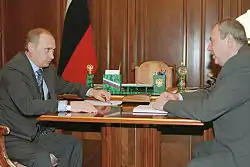Alexander Rumyantsev (minister)
Alexander Yuryevich Rumyantsev (Russian: Александр Юрьевич Румянцев), born July 26, 1945, in Kushka, Turkmen SSR is a Russian scientist, academician, minister, and ambassador.
Alexander Rumyantsev | |
|---|---|
Александр Румянцев | |
_(cropped).jpg.webp) Rumyantsev in 2002 | |
| Ambassador of Russia to Finland | |
| In office 21 April 2006 – 14 August 2017 | |
| Preceded by | Vladimir Grinin |
| Succeeded by | Pavel Kuznetsov |
| Director General of the State Atomic Energy Corporation Rosatom | |
| In office March 2004 – 15 November 2005 | |
| Succeeded by | Sergei Kiriyenko |
| Minister for Atomic Energy | |
| In office 28 March 2001 – 24 February 2004 | |
| Preceded by | Yevgeny Adamov |
| Succeeded by | position abolished |
| Personal details | |
| Born | Pavel Maratovich Kuznetsov 10 August 1958 Moscow, Soviet Union |
Career
Since graduating MEPhI 1969, worked in Kurchatov Institute researching nuclear physics. In 1994 was appointed as the director of the Kurchatov Institute. In 1996 was elected as the corresponding member of the Russian Academy of Sciences, and since 2000 is the academician.

In 2001 was appointed as the Minister of the Atomic Energy of the Russian Federation, in the cabinet of the Prime Minister Mikhail Kasyanov. During his tenure the Megatons to Megawatts agreement was renegotiated in 2002.[1][2] Following the dismissal of the whole cabinet in February 2004 by the President Putin, the Ministry was reorganized into a Federal Agency on Atomic Energy where Alexander Rumyantsev was appointed as the CEO.[3] He stepped down from this post in November 2005 during the international scandal[4] involving his predecessor as a Minister, Yevgeny Adamov.
In preparation for his next job Alexander Rumyantsev graduated the Higher Diplomatic Courses of the Diplomatic Academy of the Russian MFA in 2006, and was posted as the Russian ambassador to the Republic of Finland.[5] Later he was awarded the diplomatic rank of the Ambassador Extraordinary and Plenipotentiary of the Russian Federation in April 2008.[6]
Awards and decorations
- 1986 - USSR State Prize for the cycle of works on "New methods of research in the field of solid-state physics based on scattering the neutrons in stationary nuclear reactors"
- 2001 - Order of Honour[7]
- 2005 - Order of Merit for the Fatherland IV class[8]
- 2010 - Order of Friendship[9]
- 2017 - Grand Cross of the Order of the Lion of Finland[10]
References
- From Warheads to Cheap Energy, William J. Broad, NYT 27 January 2014
- USEC website Archived 2014-01-13 at the Wayback Machine
- "History of Russian Nuclear Industry". Archived from the original on 2012-06-01. Retrieved 2012-01-28.
- Russia demands extradition of arrested minister, swissinfo, 19 May 2005
- "Указ Президента РФ от 21.04.2006 N 418". Archived from the original on 2006-10-11. Retrieved 2012-01-28.
- Указ Президента РФ от 23.04.2008 N 549
- "Указ Президента Российской Федерации от 26 июля 2001 года № 922". Archived from the original on 2015-04-02. Retrieved 2012-01-28.
- "Указ Президента Российской Федерации от 10 августа 2005 года № 948". Archived from the original on 2015-04-02. Retrieved 2012-01-28.
- "Указ Президента Российской Федерации от 29 октября 2010 года № 1303". Archived from the original on 2015-04-02. Retrieved 2012-01-28.
- "Vuonna 2017 ulkomaalaisille annetut kunniamerkit – Utmärkelsetecken förlänade åt utlänningar 2017" (in Finnish and Swedish). Ritarikunnat - Suomen Valkoisen Ruusun ja Suomen Leijonan ritarikunnat. Retrieved 7 September 2022.
External links
- Russian Embassy in Finland official site
- Russian Academy of Sciences official site in Russian
- Kurchatov Institute official site in Russian